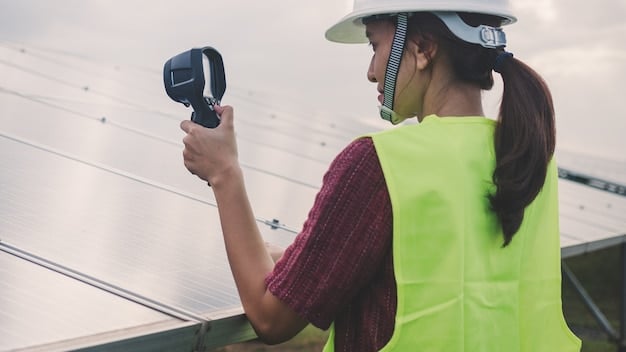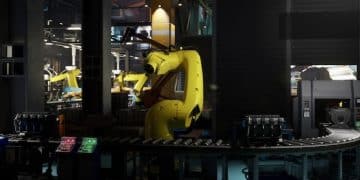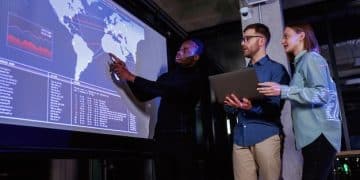Business Strategies for Soaring Energy Costs: Cut Consumption, Maximize Savings

Navigating the complexities of escalating energy costs demands proactive business strategies focused on consumption reduction and efficiency to safeguard financial health and ensure long-term sustainability.
In today’s dynamic economic landscape, businesses across the globe are grappling with an increasingly pressing challenge: soaring energy costs. This escalating expense directly impacts operational budgets, profitability, and long-term sustainability. Understanding the intricate factors driving this surge and, more importantly, implementing effective strategies to reduce consumption and maximize savings has become paramount for survival and growth. This article delves into actionable insights and strategic approaches that can empower your business to navigate this energy crisis, fostering resilience while achieving significant cost reductions.
Understanding the Energy Cost Landscape and Its Impact
The current surge in energy prices isn’t a fleeting blip; it’s a multi-faceted phenomenon driven by geopolitical events, supply chain disruptions, increased demand, and a slower-than-expected transition to renewable sources. For businesses, this translates to heightened operational expenditures, squeezing profit margins, and potentially limiting investment in growth areas. The unpredictability of these costs also makes financial planning a significant challenge, adding a layer of risk to every budget cycle.
Examining the factors contributing to this volatile environment is crucial. Geopolitical tensions, for instance, can drastically alter the supply of fossil fuels, leading to immediate price hikes. Similarly, extreme weather events, exacerbated by climate change, can strain energy grids and disrupt distribution channels, further pushing prices upwards. Meanwhile, the global push towards digitalization and automation, while beneficial for productivity, inherently increases electricity demand, putting additional pressure on existing energy infrastructures.
Global Economic Pressures
The interconnectedness of the global economy means that energy price shocks in one region can rapidly ripple across others. Businesses that rely heavily on energy-intensive processes, such as manufacturing or cold storage, are particularly vulnerable. The increased cost of production can force them to raise prices, potentially impacting consumer demand and overall market competitiveness. This creates a challenging cycle where businesses must either absorb higher costs or risk alienating their customer base.
- Volatile geopolitical situations directly affect oil and gas prices.
- Supply chain bottlenecks delay energy infrastructure projects and fuel delivery.
- Rising global demand, especially from emerging economies, outstrips supply capacity.
Furthermore, regulatory changes and carbon pricing mechanisms, while essential for environmental protection, can also add to the cost burden for businesses, especially those with high carbon footprints. Adapting to these new regulations requires not only financial investment but also a strategic shift in operational practices. Businesses that proactively embrace these changes, however, often find long-term benefits in terms of reputation, efficiency, and reduced exposure to future carbon liabilities.
Understanding these macro-level influences is the first step towards developing a robust energy management strategy. It allows businesses to anticipate potential challenges, identify areas of vulnerability, and allocate resources more effectively towards solutions that offer both immediate relief and long-term sustainability. Without this foundational understanding, energy cost reduction efforts might be reactive rather than strategic, offering temporary fixes instead of lasting improvements.
In essence, the current energy cost landscape demands a holistic approach, where businesses not only focus on internal efficiencies but also consider the broader market dynamics. This strategic foresight enables them to transform a challenge into an opportunity for innovation, driving sustainable practices and competitive advantage.
Strategic Energy Audits: Uncovering Hidden Savings
Before any significant investment in energy-saving technologies or practices, a comprehensive energy audit is an indispensable first step. This analytical process, often conducted by specialized professionals, identifies where and how energy is being consumed, pinpoints inefficiencies, and recommends tailored solutions. Think of it as a detailed health check for your building’s energy system, revealing areas for immediate improvement and long-term optimization.
An effective energy audit goes beyond merely checking utility bills. It involves detailed on-site inspections, data analysis of energy consumption patterns, and an evaluation of existing equipment, insulation, and operational procedures. This thorough examination helps businesses understand their energy baseline and identify specific areas where consumption can be significantly reduced. For instance, an audit might reveal that outdated HVAC systems are major energy hogs, or that poor insulation leads to excessive heat loss or gain.
Types of Audits and Their Benefits
There are various levels of energy audits, from basic walk-throughs to highly detailed technical analyses. Basic audits provide a quick overview of potential savings, while more in-depth audits involve detailed measurements, sophisticated modeling, and a comprehensive list of recommended actions with estimated costs and payback periods. The choice depends on the size and complexity of your business operations and the depth of insight required.
- Level 1 (Walk-Through): Identifies low-cost, quick-win opportunities.
- Level 2 (Energy Survey and Analysis): Detailed analysis of energy usage, cost-benefit for capital improvements.
- Level 3 (Investment Grade): Most comprehensive, involving detailed engineering analysis for major investments.
The benefits of a thorough energy audit extend far beyond just identifying savings. It provides valuable data that supports informed decision-making, prioritizes investments based on return on investment (ROI), and helps secure financing for energy efficiency projects. Moreover, it raises awareness among employees about energy consumption, fostering a culture of conservation within the organization. This collective awareness can lead to significant behavioral changes, further enhancing energy savings.
Even implementing simple, low-cost measures identified during an audit, such as optimizing thermostat settings or ensuring proper sealing around windows and doors, can yield surprising results. The key is to act on the audit’s findings, developing a phased implementation plan that balances immediate savings with long-term strategic goals. Regular re-audits can also help track progress, identify new opportunities, and ensure that energy management strategies remain effective over time.
Ultimately, a strategic energy audit is not an expense but an investment. It provides the roadmap for a more energy-efficient and cost-effective operation, positioning your business for greater financial stability in a world of volatile energy prices. By making data-driven decisions, businesses can avoid costly mistakes and focus their resources on solutions that deliver the greatest impact.
Implementing Energy-Efficient Technologies and Practices
Once an energy audit has pinpointed areas for improvement, the next crucial step is to implement energy-efficient technologies and practices. This involves a multifaceted approach, ranging from upgrading physical infrastructure to fostering a culture of energy conservation among employees. The goal is not just to reduce consumption but to optimize every aspect of energy use within the business, transforming operations into lean, green machines.
One of the most impactful strategies involves upgrading lighting systems to LED technology. LEDs consume significantly less energy, have a longer lifespan, and provide better illumination, leading to substantial energy savings and reduced maintenance costs. Similarly, investing in high-efficiency HVAC (heating, ventilation, and air conditioning) systems, along with smart thermostats, can dramatically lower heating and cooling expenses, which often account for a significant portion of a business’s energy bill.
Key Technological Upgrades and Behavioral Shifts
Beyond major infrastructure changes, there are numerous other technological solutions and operational changes that can make a substantial difference. These include installing occupancy sensors to turn off lights in empty rooms, upgrading to energy-efficient appliances, and even implementing demand-side management systems that optimize energy use during peak hours to avoid higher tariffs. The integration of Internet of Things (IoT) devices can also provide real-time data on energy consumption, enabling businesses to identify and address inefficiencies promptly.
- Upgrade to LED lighting and install motion sensors.
- Invest in high-efficiency HVAC and smart climate control systems.
- Optimize insulation in buildings, sealing leaks and gaps.
- Utilize power strips with timer functions for office equipment.
Behavioral changes among employees are equally vital. Encouraging staff to turn off lights and computers at the end of the day, unplug chargers, and report energy waste can collectively lead to substantial savings. Training programs can raise awareness about energy efficiency and empower employees to contribute actively to the company’s conservation efforts. A culture of accountability and shared responsibility for energy use can greatly amplify the impact of technological investments.
Furthermore, businesses should explore options for power factor correction, which optimizes the efficiency of electrical systems and can reduce energy waste. For businesses with large machinery, regular maintenance and calibration are essential to ensure they operate at peak efficiency, minimizing energy loss. Simple actions like cleaning air filters regularly or lubricating moving parts can prevent unnecessary energy consumption. These seemingly minor adjustments, when consistently applied, accrue significant long-term savings.

Ultimately, implementing energy-efficient technologies and practices is an ongoing process. It requires continuous monitoring, evaluation, and adaptation to new advancements and changing needs. By staying proactive and committed to energy optimization, businesses can not only mitigate rising costs but also enhance their environmental stewardship, fostering a reputation as socially responsible entities. This dual benefit underscores the importance of integrating energy efficiency into the core operational strategy.
Leveraging Renewable Energy Sources and Green Initiatives
As energy costs continue their upward trajectory, businesses are increasingly looking beyond mere consumption reduction towards generating their own power through renewable energy sources. Investing in green initiatives offers a dual advantage: it insulates businesses from volatile market prices and positions them as leaders in environmental sustainability. The transition to renewables, while requiring initial capital, promises long-term financial stability and a significant reduction in carbon footprint.
Solar power, particularly through rooftop solar panel installations, is becoming an increasingly viable option for many businesses. Advances in technology have made solar more efficient and cost-effective, with many governments offering incentives, tax credits, and grants to encourage adoption. Businesses with suitable roof space can significantly offset their grid electricity consumption, potentially even becoming net energy exporters, selling surplus power back to the grid for additional revenue.
Exploring On-Site and Off-Site Renewable Solutions
Beyond solar, wind power, geothermal systems, and biomass are other renewable options depending on geographical location and business needs. For businesses without sufficient space for on-site generation, options like purchasing renewable energy credits (RECs) or participating in community solar projects allow them to support renewable energy development and claim green energy usage without direct installation. These off-site solutions offer flexibility and demonstrate a commitment to sustainability.
- Install rooftop solar panels to generate on-site electricity.
- Explore power purchase agreements (PPAs) for off-site renewable energy.
- Invest in geothermal heating and cooling systems where feasible.
- Consider biomass energy for operations with access to organic waste.
The financial benefits of renewable energy extend beyond immediate cost savings. They include potential tax incentives, reduced exposure to carbon taxes, and enhanced brand reputation, which can attract environmentally conscious customers and investors. Companies that prioritize sustainability often find it easier to recruit and retain talent, as a strong commitment to environmental values resonates with a growing segment of the workforce.
It’s also important to consider the long-term trends. As renewable energy technologies become more widespread and efficient, their costs are diminishing, making them an increasingly attractive investment. Furthermore, regulatory environments are evolving to support this transition, offering a more stable and predictable landscape for renewable energy projects compared to fossil fuel markets. This shift makes a strong business case for integrating green initiatives into a company’s strategic planning.
Embracing renewable energy is not just an environmental choice; it’s a shrewd business decision that enhances resilience, forecasts cost stability, and aligns with global sustainability goals. By actively seeking out and implementing green power solutions, businesses can transform their energy consumption model, moving from passive consumers to active producers, and secure a more sustainable future.
Optimizing Supply Chain and Logistics for Energy Efficiency
Energy consumption isn’t confined to a business’s operational facilities; it extends throughout its entire supply chain and logistics network. From raw material extraction and transportation to manufacturing, warehousing, and final delivery, every step involves energy use. Optimizing these processes for energy efficiency can unlock substantial savings and reduce the overall carbon footprint, demonstrating a holistic commitment to sustainability.
Transportation is often a major energy guzzler in the supply chain. Businesses can explore various strategies to reduce fuel consumption, such as optimizing delivery routes to minimize mileage, consolidating shipments to ensure full truckloads, and investing in more fuel-efficient vehicles or even electric fleets. The adoption of advanced telematics and route optimization software can significantly improve efficiency, reducing both fuel costs and delivery times.
Key Areas for Supply Chain Energy Optimization
Warehousing and storage also present significant opportunities for energy savings. Implementing energy-efficient lighting, optimizing warehouse layout for better workflow, using automated storage and retrieval systems (AS/RS) that reduce the need for constantly lit and heated spaces, and ensuring proper insulation can dramatically lower electricity consumption. Even simple measures like regularly maintaining refrigeration units can prevent energy waste and significant operational costs.
- Optimize transportation routes and consolidate shipments.
- Invest in fuel-efficient or electric vehicle fleets.
- Implement energy-efficient lighting and smart climate control in warehouses.
- Utilize advanced supply chain analytics to identify energy hotspots.
Furthermore, businesses should work collaboratively with their suppliers and logistics partners to identify and implement energy-saving measures across the extended supply chain. This could involve encouraging suppliers to adopt green manufacturing processes, using more sustainable packaging materials that require less energy to produce, or partnering with logistics providers committed to reducing their carbon emissions. A collective effort yields greater impact and fosters a more sustainable ecosystem.
Data analytics plays a crucial role in supply chain energy optimization. By analyzing data on transportation patterns, warehouse energy consumption, and supplier practices, businesses can identify bottlenecks and inefficiencies, make data-driven decisions, and continuously improve their energy performance. This continuous improvement mindset is essential for long-term sustainability and cost reduction in a complex supply chain network.
By taking a comprehensive view of energy consumption across their entire supply chain and logistics operations, businesses can uncover significant savings opportunities that might otherwise be overlooked. This strategic approach not only reduces operational costs but also enhances the company’s reputation as a responsible and environmentally conscious entity, appealing to modern consumers and stakeholders.
Government Programs and Financial Incentives for Businesses
Navigating the transition to a more energy-efficient and sustainable operation can be a significant financial undertaking for businesses. Fortunately, numerous government programs and financial incentives are available at federal, state, and local levels to help ease this burden. These initiatives aim to encourage businesses to invest in energy efficiency upgrades, renewable energy installations, and other green technologies, promoting both economic stability and environmental stewardship.

Federal programs, for instance, often include tax credits for specific energy-efficient equipment purchases, grants for renewable energy projects, and loan programs designed to help businesses finance sustainability initiatives. The Inflation Reduction Act (IRA) in the US, for example, offers substantial incentives for clean energy investments, making projects that were once cost-prohibitive now financially attractive. Businesses should actively research these federal opportunities, as they can significantly reduce the upfront cost of green investments.
State, Local, and Utility-Specific Incentives
Beyond federal support, many states and local municipalities offer their own unique incentive programs tailored to regional needs and priorities. These can include property tax abatements for installing solar panels, rebates for energy-efficient appliance upgrades, or low-interest loans for comprehensive building retrofits. Utility companies also frequently provide incentives, such as rebates for reducing peak energy demand or for upgrading to more efficient lighting and HVAC systems, as it helps them manage grid load more effectively.
- Research federal tax credits (e.g., from the Inflation Reduction Act).
- Investigate state-level grant programs and low-interest loans.
- Check with local municipalities for property tax abatements or specific energy rebates.
- Consult with your utility provider for efficiency incentive programs.
The process of applying for these incentives can sometimes be complex, requiring detailed documentation and adherence to specific eligibility criteria. Businesses should consider working with energy consultants or specialized financial advisors who are knowledgeable about the landscape of available programs and can assist with the application process. This expertise can maximize the chances of securing funding and ensure compliance with all requirements.
Furthermore, exploring public-private partnerships can open doors to additional funding and expertise for large-scale energy efficiency projects. These collaborations can leverage the financial resources of both government bodies and private investors, accelerating the adoption of sustainable technologies and practices. Tapping into such networks can provide access to shared knowledge, best practices, and innovative solutions, creating a synergistic environment for advanced energy management.
By strategically leveraging these government programs and financial incentives, businesses can significantly reduce the financial burden of transitioning to more energy-efficient operations. These programs not only make sustainability more affordable but also reinforce the economic benefits of going green, paving the way for a more resilient and environmentally responsible business future.
Future-Proofing Your Business: Long-Term Energy Resilience
In a world of evolving energy markets and accelerating climate change, immediate cost savings are crucial, but long-term energy resilience is paramount for sustained business success. Future-proofing your business against energy volatility involves a strategic shift towards self-sufficiency, intelligent resource management, and continuous adaptation. This proactive approach ensures that your operations remain stable and competitive regardless of external energy shocks.
One key aspect of future-proofing is investing in energy storage solutions, such as battery systems, especially in conjunction with renewable energy installations. These systems allow businesses to store excess energy generated during off-peak hours or from renewable sources, and then use it during peak demand or when grid prices are higher. This not only optimizes energy usage but also provides a backup power source, enhancing operational continuity during outages.
Adopting Smart Technologies and Circular Economy Principles
The integration of smart building management systems (BMS) and artificial intelligence (AI) is another critical step. These technologies can monitor and analyze energy consumption in real-time, predict future demand, and automatically adjust systems like HVAC and lighting for optimal efficiency. AI-driven analytics can identify patterns and recommend adjustments that human oversight might miss, leading to continuous, incremental improvements in energy performance.
- Invest in energy storage solutions (e.g., batteries) for resilience.
- Implement smart building management systems and AI for optimization.
- Embrace circular economy principles to reduce material and energy waste.
- Foster a culture of continuous innovation in energy management.
Furthermore, adopting circular economy principles can contribute significantly to energy resilience. By designing products and processes for durability, reusability, and recyclability, businesses can reduce their reliance on new raw materials and the energy-intensive processes required to produce them. This not only conserves energy but also minimizes waste and creates new revenue streams through material recovery and reuse, enhancing overall resource efficiency.
Strategic diversification of energy sources is also vital. Relying too heavily on a single energy type, even renewables, can expose a business to risks. Exploring a mix of solar, wind, geothermal, or even small-scale hydro where applicable, can provide a more robust and reliable energy portfolio. This diversified approach mitigates risks associated with intermittency or regional supply fluctuations, ensuring a more consistent energy supply.
Maintaining an awareness of technological advancements and regulatory changes in the energy sector is also crucial. The energy landscape is continually evolving, with new innovations and policies emerging regularly. Businesses that stay informed and are agile enough to adapt to these changes will be better positioned to capitalize on new opportunities and avoid potential pitfalls. This involves ongoing research, participation in industry forums, and a willingness to experiment with new solutions.
Ultimately, future-proofing isn’t about isolated actions; it’s about embedding energy resilience into the core strategy and culture of the business. It’s a continuous journey of innovation, adaptation, and commitment to sustainability, ensuring that your business not only survives but thrives in an unpredictable energy future.
| Key Strategy | Brief Description |
|---|---|
| 📊 Energy Audits | Identify consumption patterns and inefficiencies through detailed analysis. |
| 💡 Tech Upgrades | Implement LED lighting, efficient HVAC, and smart controls for savings. |
| ☀️ Renewables | Invest in solar or wind to generate own power and reduce grid reliance. |
| 🔗 Supply Chain Opt. | Streamline logistics and warehousing for reduced energy usage. |
Frequently Asked Questions
▼
Soaring energy costs stem from a confluence of factors, including geopolitical instabilities affecting supply, increased global demand post-pandemic, supply chain disruptions, and the slower-than-anticipated transition to widespread renewable energy sources. These elements combine to create a volatile market where prices escalate rapidly, directly impacting operational budgets and profitability for businesses across various sectors.
▼
An energy audit is a systematic inspection and analysis of a building’s energy usage to identify inefficiencies and recommend cost-effective improvements. It helps businesses pinpoint where and how energy is being wasted, enabling targeted upgrades to lighting, HVAC, insulation, and equipment. This process provides a clear roadmap for reducing consumption and can lead to significant long-term savings once implemented effectively.
▼
Yes, investing in renewable energy can lead to substantial long-term savings. While the initial capital outlay can be significant, solar panels, for instance, dramatically reduce reliance on grid electricity, buffering your business from price volatility. Furthermore, numerous government incentives, tax credits, and grants can offset installation costs, making the return on investment increasingly attractive over the lifespan of the system, fostering financial stability.
▼
Absolutely. Governments at federal, state, and local levels, along with many utility companies, offer a variety of programs to encourage businesses to adopt energy-efficient technologies and renewable energy solutions. These include tax credits, rebates, grants, and low-interest loans. Researching these incentives thoroughly, often with the help of specialized consultants, can significantly reduce the financial burden of green initiatives and accelerate their adoption.
▼
Fostering a culture of energy conservation among employees is crucial. This can be achieved through regular training and awareness campaigns, clear communication of energy-saving goals, and leading by example. Encouraging simple actions like turning off lights and computers, reporting leaks, and optimizing thermostat settings can collectively yield significant savings. Recognizing and rewarding energy-conscious behavior can also motivate greater participation and sustained effort.
Conclusion
The imperative for businesses to actively manage and reduce their energy consumption has never been clearer. Against a backdrop of perpetually rising and volatile energy costs, strategic planning, technological adoption, and a commitment to sustainability are not merely optional extras but essential components of a resilient and profitable business model. By embracing comprehensive energy audits, investing in efficient technologies, leveraging renewable sources, optimizing supply chains, and utilizing available incentives, businesses can transform a significant challenge into a powerful opportunity for growth, innovation, and long-term stability.





